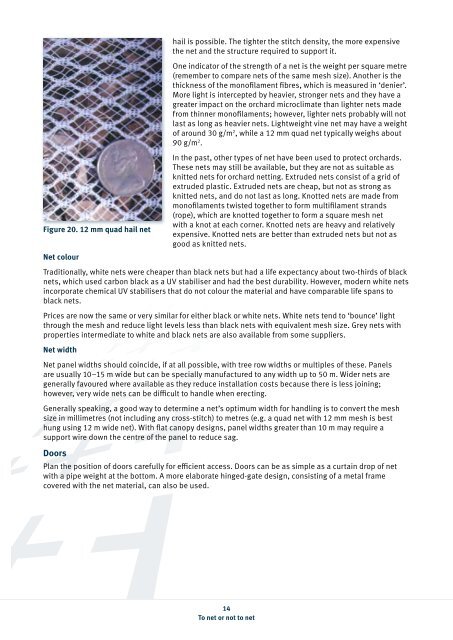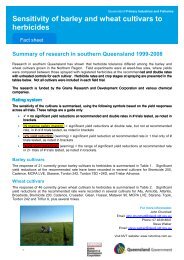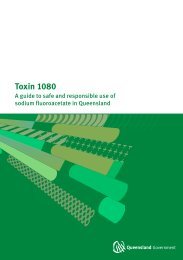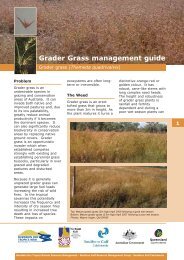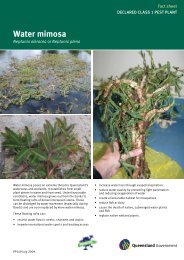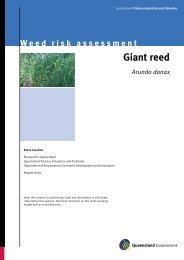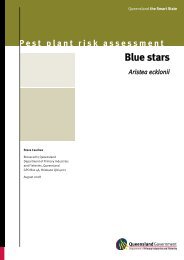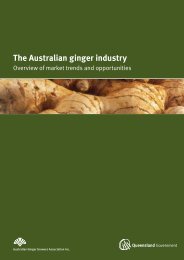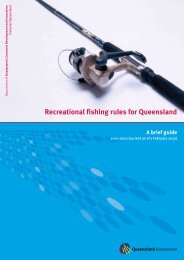To net or not to net - 3rd edition - Department of Primary Industries
To net or not to net - 3rd edition - Department of Primary Industries
To net or not to net - 3rd edition - Department of Primary Industries
You also want an ePaper? Increase the reach of your titles
YUMPU automatically turns print PDFs into web optimized ePapers that Google loves.
Figure 20. 12 mm quad hail <strong>net</strong><br />
Net colour<br />
hail is possible. The tighter the stitch density, the m<strong>or</strong>e expensive<br />
the <strong>net</strong> and the structure required <strong>to</strong> supp<strong>or</strong>t it.<br />
One indicat<strong>or</strong> <strong>of</strong> the strength <strong>of</strong> a <strong>net</strong> is the weight per square metre<br />
(remember <strong>to</strong> compare <strong>net</strong>s <strong>of</strong> the same mesh size). A<strong>not</strong>her is the<br />
thickness <strong>of</strong> the mon<strong>of</strong>ilament fibres, which is measured in ‘denier’.<br />
M<strong>or</strong>e light is intercepted by heavier, stronger <strong>net</strong>s and they have a<br />
greater impact on the <strong>or</strong>chard microclimate than lighter <strong>net</strong>s made<br />
from thinner mon<strong>of</strong>ilaments; however, lighter <strong>net</strong>s probably will <strong>not</strong><br />
last as long as heavier <strong>net</strong>s. Lightweight vine <strong>net</strong> may have a weight<br />
<strong>of</strong> around 30 g/m 2 , while a 12 mm quad <strong>net</strong> typically weighs about<br />
90 g/m 2 .<br />
In the past, other types <strong>of</strong> <strong>net</strong> have been used <strong>to</strong> protect <strong>or</strong>chards.<br />
These <strong>net</strong>s may still be available, but they are <strong>not</strong> as suitable as<br />
knitted <strong>net</strong>s f<strong>or</strong> <strong>or</strong>chard <strong>net</strong>ting. Extruded <strong>net</strong>s consist <strong>of</strong> a grid <strong>of</strong><br />
extruded plastic. Extruded <strong>net</strong>s are cheap, but <strong>not</strong> as strong as<br />
knitted <strong>net</strong>s, and do <strong>not</strong> last as long. K<strong>not</strong>ted <strong>net</strong>s are made from<br />
mon<strong>of</strong>ilaments twisted <strong>to</strong>gether <strong>to</strong> f<strong>or</strong>m multifilament strands<br />
(rope), which are k<strong>not</strong>ted <strong>to</strong>gether <strong>to</strong> f<strong>or</strong>m a square mesh <strong>net</strong><br />
with a k<strong>not</strong> at each c<strong>or</strong>ner. K<strong>not</strong>ted <strong>net</strong>s are heavy and relatively<br />
expensive. K<strong>not</strong>ted <strong>net</strong>s are better than extruded <strong>net</strong>s but <strong>not</strong> as<br />
good as knitted <strong>net</strong>s.<br />
Traditionally, white <strong>net</strong>s were cheaper than black <strong>net</strong>s but had a life expectancy about two-thirds <strong>of</strong> black<br />
<strong>net</strong>s, which used carbon black as a UV stabiliser and had the best durability. However, modern white <strong>net</strong>s<br />
inc<strong>or</strong>p<strong>or</strong>ate chemical UV stabilisers that do <strong>not</strong> colour the material and have comparable life spans <strong>to</strong><br />
black <strong>net</strong>s.<br />
Prices are now the same <strong>or</strong> very similar f<strong>or</strong> either black <strong>or</strong> white <strong>net</strong>s. White <strong>net</strong>s tend <strong>to</strong> ‘bounce’ light<br />
through the mesh and reduce light levels less than black <strong>net</strong>s with equivalent mesh size. Grey <strong>net</strong>s with<br />
properties intermediate <strong>to</strong> white and black <strong>net</strong>s are also available from some suppliers.<br />
Net width<br />
Net panel widths should coincide, if at all possible, with tree row widths <strong>or</strong> multiples <strong>of</strong> these. Panels<br />
are usually 10–15 m wide but can be specially manufactured <strong>to</strong> any width up <strong>to</strong> 50 m. Wider <strong>net</strong>s are<br />
generally favoured where available as they reduce installation costs because there is less joining;<br />
however, very wide <strong>net</strong>s can be difficult <strong>to</strong> handle when erecting.<br />
Generally speaking, a good way <strong>to</strong> determine a <strong>net</strong>’s optimum width f<strong>or</strong> handling is <strong>to</strong> convert the mesh<br />
size in millimetres (<strong>not</strong> including any cross-stitch) <strong>to</strong> metres (e.g. a quad <strong>net</strong> with 12 mm mesh is best<br />
hung using 12 m wide <strong>net</strong>). With flat canopy designs, panel widths greater than 10 m may require a<br />
supp<strong>or</strong>t wire down the centre <strong>of</strong> the panel <strong>to</strong> reduce sag.<br />
Do<strong>or</strong>s<br />
Plan the position <strong>of</strong> do<strong>or</strong>s carefully f<strong>or</strong> efficient access. Do<strong>or</strong>s can be as simple as a curtain drop <strong>of</strong> <strong>net</strong><br />
with a pipe weight at the bot<strong>to</strong>m. A m<strong>or</strong>e elab<strong>or</strong>ate hinged-gate design, consisting <strong>of</strong> a metal frame<br />
covered with the <strong>net</strong> material, can also be used.<br />
14<br />
<strong>To</strong> <strong>net</strong> <strong>or</strong> <strong>not</strong> <strong>to</strong> <strong>net</strong>


